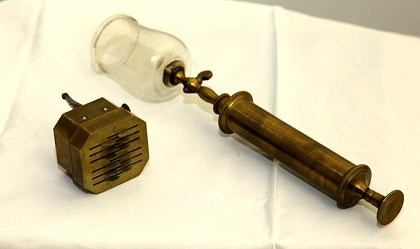Guest Post - Blood Letting and Opium: the Treatment of Febrile Diseases in Cork Street Fever Hospital in the Early 1800s
 |
| Picture reprinted in annual reports (CSFH/1/2/1) |
This guest post is by Noel Bennett, who completed an MA in Local History in NUI Maynooth in October 2010. Noel's thesis was entitled 'The House of Recovery: Cork Street Fever Hospital, 1804-1854'. The following article is formed from extracts from this thesis.
The early nineteenth century was a period when the medical
profession appear to be baffled by the origin and spread of fever and an era
when physicians in Dublin were as likely to suffer fever infection as their
patients. Their strong belief that the weather was a major factor led to the
collation of the weather conditions by staff in Cork Street Fever Hospital for every day in the first three months of
1816 to an entire year in 1837. In 1837 every physician in the hospital was affected
by fever and two died. The threat posed by fever to the health of Dublin’s
inhabitants in the early 1800s was apparent, as every decade after 1810 saw a
least one serious outbreak of fever, with major epidemics occurring in Dublin
in 1818,1826,1832,1837 and 1847.
Physicians working in Cork Street Fever Hospital were also unsure of
how best to treat many febrile diseases, and lengthy sections of annual medical
reports from this period were devoted to analysis of the merits of various
methods of treatment. The annual report of 1813 contains a lengthy review of
the practice of blood letting which was being practiced by Dr. Thomas Mills in
the hospital. The hospital physicians reviewed the survival rate of his
patients by analysing 2,240 of his cases. They came to the conclusion that
blood letting exerted no influence in rendering the disease less fatal or less
protracted. They concluded their review by stating that they owed it to the
public and the profession not to be silent on the claims ‘so boldly put forward
and so pertinaciously maintained.’
The 1815 report returns once again to the issue of blood letting
with one of the physicians, Dr. John O’Brien, believing that it had a role to
play in the treatment of fever. The other physicians were apprehensive that
even the loss of a small quantity of blood was likely to lead to exhaustion.
O’Brien went on to question the preferred treatment which was to support the
patients strength with ‘enormous’ quantities of wine whose only effect was to increase the
‘determination of blood to the head’ and aggravate the problem it was intended
to cure. Blood letting involved shaving the head of
the patient and washing the head frequently with vinegar and water. Leeches
were then applied to the temples and if this produced no relief, the temporal
artery was opened and four to six ounces of blood removed. Alcohol was still widely used in 1827 when
the board enquired into the quantities purchased. In the first four months of
that year there had been a daily average of 355 patients and thirty gallons of
spirits and 41 dozen of wine of wine had been consumed.
 |
Passage from 1815 Annual Report, written by Dr John O'Brien, concerning blood-letting (CSFH/1/2/1/1)
|
In the 1837 annual report opium is mentioned as a treatment for
patients suffering from typhus and delirium tremens. It was administered in
powder form and described as Dover’s powder. Dr George A. Kennedy was of the
opinion that there was no drug that requires more observation than the use of
opium in the treatment of fever. Wine however was still preferred with an
average quantity of eight ounces over twenty four hours being the recommended
dose.
 |
| A scarifying kit, an example of 19 century blood-letting equipment |
The annual reports also contain many suggestions for preventative
measures to stem to spread of fever, which seem more sensible to present-day
eyes. As fever raged in Dublin in 1818, the Government wrote to the hospital
requesting their views on the likely cause and solution. The managing committee
and the physicians both replied separately to the request. The committee
referred to the poor harvests of 1816 and 1817 which they said caused a degree
of distress scarcely to be believed. The lack of employment, scarcity and price
of food all induced a more than usual neglect of cleanliness in the homes of
the poor and in their persons. They suggested that anything that would promote
cleanliness and sobriety among the poor would lead to abatement of the present
epidemic and of fever generally. A copious supply of water would promote this
objective. The physicians emphasised the need for
additional facilities for the hospital noting that patients had to wait days
for admission and some had died during the waiting period. They also noted a
reduction in the number of beggars on the street. It was believed that beggars
contributed to the spread of contagion and the physicians hoped that the evil
of permitting them to be at large would not recur.